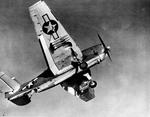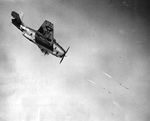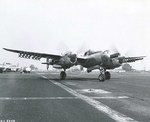HVAR Missile
| Country of Origin | United States |
| Type | Missile |
| Diameter | 127.000 mm |
| Length | 1.727 m |
| Ammunition Weight | 60.78 kg |
| Range | 41.148 km |
| Muzzle Velocity | 419 m/s |
Contributor: David Stubblebine
ww2dbaseThe High Velocity Aircraft Rocket was officially abbreviated HVAR but they were more widely known as "Holy Moses." HVARs were unguided air-to-ground rockets developed by the United States during World War II and were used extensively in 1944 and 1945 and also in the Korean War.The HVAR was developed by engineers at California Institute of Technology (Caltech) in Pasadena, California, United States as an improvement on the FFAR, the Forward Firing Aircraft Rocket (not to be confused with the later Folding Fin Aerial Rocket, an air-to-air missile also called FFAR). The original FFAR had a 5-inch diameter warhead on a 3-inch rocket motor. The HVAR had a similar 5-inch warhead but was mounted on a 5-inch rocket motor. The larger rocket housed almost three times as much propellant and gave the HVAR higher velocities with increased impact forces. The bigger advantage from the higher velocities, however, was a flatter trajectory that greatly improved accuracy over the FFAR.
Initially, HVAR warheads were modified shells from the Navy's ubiquitous 5-inch guns. Later HVAR warheads were purpose-built for different applications including general-purpose, armor piercing, and white phosphorous; but the high-explosive general-purpose variant was by far the most common. HVAR development was completed in time for them to be first used in Jun 1944 as part of the D-Day operations in Normandy, France, particularly after the landings during the breakout period.
HVARs could penetrate four feet of reinforced concrete and were used against all manners of surface targets including pillboxes, anti-aircraft gun emplacements, ammunition and fuel dumps, tanks, locomotives, bunkers, parked aircraft, and surfaced submarines.
These rockets were most frequently loaded onto Navy F4U Corsairs, F6F Hellcats, and TBF/TBM Avengers in the Pacific theater but they were also fired from a vast array of other aircraft types including P-47 Thunderbolts, P-51 Mustangs, P-38 Lightnings, SB2C Helldivers, PV-2 Harpoons, and B-25 Mitchell bombers. The British Coastal Command specially modified their Liberator III long-range patrol bombers to fire the HVAR, which they found particularly effective against surfaced German submarines.
Over a million HVARs were produced during World War II and production continued until 1955. HVARs remained in the US Navy's inventory until the mid-1960s.
Sources:
United States Navy
Smithsonian National Air and Space Museum
United States Air Force
Spaceline Rocket History
War Thunder Wiki
UBoat.net
Encyclopedia Britannica
Wikipedia ww2dbase
Last Major Revision: May 2021
HVAR Missile Interactive Map
Photographs
 |  |  |  |
Please consider supporting us on Patreon. Even $1 per month will go a long way! Thank you. Please help us spread the word: Stay updated with WW2DB: |
Search WW2DB
News
- » US Government Plans to Purge WW2 Information (17 Mar 2025)
- » WW2DB's 20th Anniversary (29 Dec 2024)
- » Wreck of USS Edsall Found (14 Nov 2024)
- » See all news
Current Site Statistics
- » 1,167 biographies
- » 337 events
- » 44,601 timeline entries
- » 1,243 ships
- » 350 aircraft models
- » 207 vehicle models
- » 376 weapon models
- » 123 historical documents
- » 261 facilities
- » 470 book reviews
- » 28,520 photos
- » 367 maps
Famous WW2 Quote
"Never in the field of human conflict was so much owed by so many to so few."Winston Churchill, on the RAF
Support Us
Please consider supporting us on Patreon. Even $1 a month will go a long way. Thank you!
Or, please support us by purchasing some WW2DB merchandise at TeeSpring, Thank you!